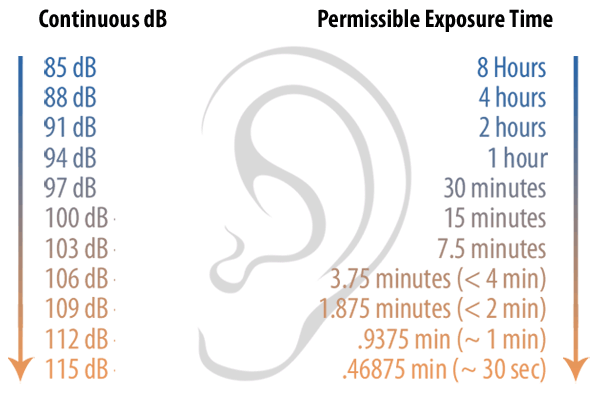I tend to stand on a soap box during my sound unit and take the opportunity to talk about sound safety. [Other related Blog of Phyz posts:
quiet fireworks and
firework sound safety.] I discuss decibel scales and show students several graphics with common noises and their values. Some of my favorites are below:
But it is sometimes hard for students to understand all the principles at once. I want to discuss allowed time duration, compare sounds they can relate to, talk about decibel reducing measures, and more. I find myself flipping back and forth between graphics during lectures and still not getting it all together.
I found
this infographic that details over 60 noises with their decibel level, marked OSHA standards and suggested exposure times. The graphic itself is too large to view all at once but I loved the format. Noises were divided up as occupational or non-occupational noises. I typed up all of the activities with their decibel levels into a
word document and selected 40 that I thought provided a range of activities students would relate to. I created another
document for printing with the sounds, and OSHA recommendations. I cut out each one, mounted them to thicker bright paper and we were ready to go.
In class I explained the decibel scale to students and showed them a few examples. Then I passed out one sound slip to each student and asked them to arrange themselves into order from 0 dB and up. After they were arranged students took turns reading their sound and decibel rating. As they were sounding off (*
ba dum ching*) I added in the cards describing the sound level (i.e. "comfortable 50 dB" or "Extremely Loud 100 dB") and the cards with suggested exposure times.
Students were surprised to learn the average decibel level of several common noise. They were shocked to see how many of them were past OSHA recommendations like "ear damage can occur here," or "unprotected noise exposure not allowed past this level." It gave them a chance to see all my talking points at once and they got to get up and move.

Space was an issue as 35 students shoulder to shoulder take up some space. I tried in my classroom for students to stand across the front of the room but they ended up in a weird convex arc and couldn't see or hear everyone else. I tried outside as pictured above but being right next to the street (on the other side of that fence) made it even harder to hear. In the future I would have arranged them in a circle around the room so that they could see everyone else. I would also hand students either a pictures of or the actual sound reducing devices where they would be needed to reduce the noises to a safe level. For example, students at 100 decibels would hold your basic foam ear plugs to show that their 20 dB reduction rating could lower those noises to a safe 80 dB. All in all I like the activity and look forward to refining it in the future.


